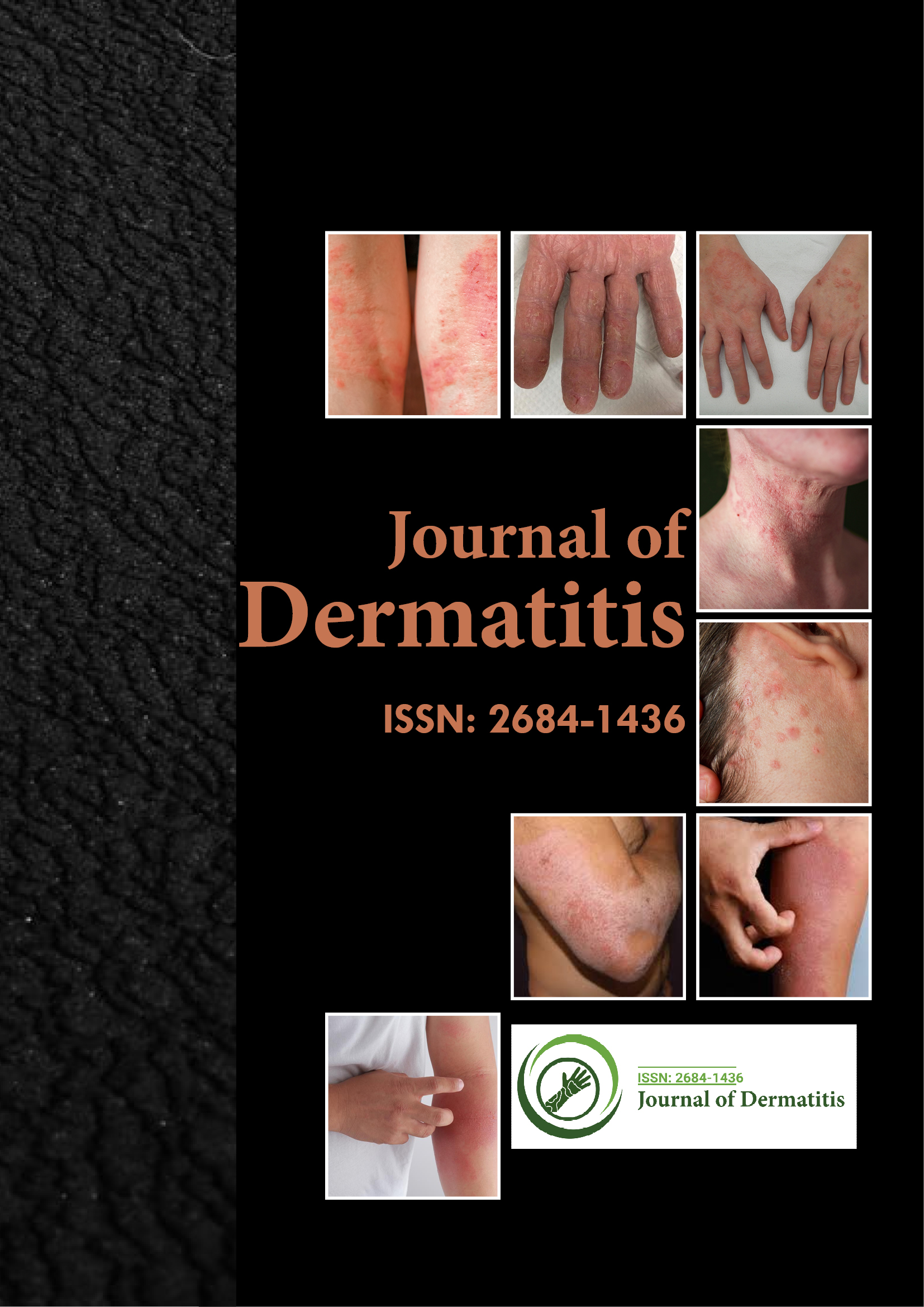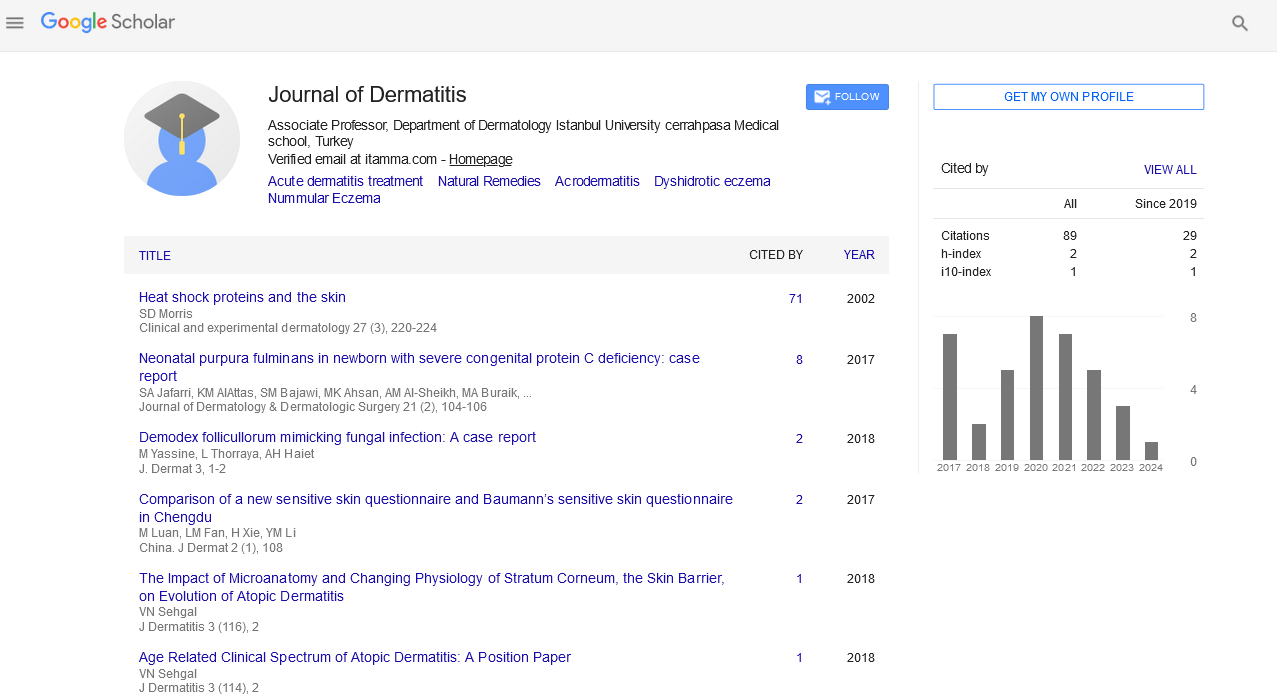Indexed In
- RefSeek
- Hamdard University
- EBSCO A-Z
- Euro Pub
- Google Scholar
Useful Links
Share This Page
Journal Flyer

Open Access Journals
- Agri and Aquaculture
- Biochemistry
- Bioinformatics & Systems Biology
- Business & Management
- Chemistry
- Clinical Sciences
- Engineering
- Food & Nutrition
- General Science
- Genetics & Molecular Biology
- Immunology & Microbiology
- Medical Sciences
- Neuroscience & Psychology
- Nursing & Health Care
- Pharmaceutical Sciences
Commentary - (2025) Volume 10, Issue 2
Innovative Therapies for Severe Psoriasis: A Comprehensive Overview
Yi Zou*Received: 19-Jan-2024, Manuscript No. JOD-24-24655; Editor assigned: 23-Jan-2024, Pre QC No. JOD-24-24655 (PQ); Reviewed: 06-Feb-2024, QC No. JOD-24-24655; Revised: 06-Jan-2025, Manuscript No. JOD-24-24655 (R); Published: 13-Jan-2025, DOI: 10.35248/2684-1436.25.10.274
Description
Psoriasis, a chronic inflammatory skin condition, affects millions of people worldwide, causing red, scaly plaques that can be not only physically discomforting but also emotionally distressing. While various treatment options exist for managing psoriasis, individuals with severe forms of the condition often face significant challenges in finding effective and sustainable relief. In recent years, innovative therapies have emerged as promising avenues in the pursuit of improved outcomes for severe psoriasis.
Severe psoriasis, often characterized by extensive skin involvement, frequent flares, and resistance to conventional treatments, requires a specialized and targeted approach. Traditional treatments, including topical steroids, phototherapy, and oral systemic medications, may not provide sufficient control for individuals with severe psoriasis. As a result, researchers and clinicians have explored novel therapeutic options that offer more targeted mechanisms of action and potentially better outcomes for those dealing with the challenges of severe psoriasis.
One notable advancement in the field of psoriasis treatment is the introduction of biologic therapies. Biologics are a class of drugs designed to target specific components of the immune system involved in the inflammatory processes underlying psoriasis. Tumor Necrosis Factor-Alpha (TNF-α) inhibitors, such as infliximab, etanercept, and adalimumab, were among the first biologics approved for psoriasis treatment. These medications block the action of TNF-α, a pro-inflammatory cytokine implicated in the pathogenesis of psoriasis.
While TNF-α inhibitors have demonstrated efficacy in many cases of severe psoriasis, the development of new biologics with different mechanisms of action has expanded the treatment landscape. Interleukin (IL)-17 inhibitors, including secukinumab, ixekizumab, and brodalumab, represent a significant innovation. IL-17 is a cytokine involved in the inflammatory cascade seen in psoriasis, and targeting it directly has shown remarkable results in reducing psoriatic plaques and improving quality of life for individuals with severe psoriasis.
IL-23 inhibitors, another class of biologics, have also gained prominence in severe psoriasis management. Agents like guselkumab, tildrakizumab, and risankizumab selectively target IL-23, a cytokine implicated in the abnormal immune response observed in psoriasis. By focusing on IL-23, these biologics offer a more specific and targeted approach, potentially minimizing side effects and enhancing therapeutic efficacy.
One of the advantages of biologic therapies is their ability to provide long-lasting relief, reducing the frequency of flare-ups and allowing for improved quality of life. However, these treatments often involve injections or infusions and may require regular monitoring for potential side effects. Despite these considerations, the advent of biologic therapies has been transformative in severe psoriasis management, offering hope and meaningful outcomes for many individuals.
Another innovative approach in severe psoriasis treatment involves small molecule inhibitors. Unlike biologics, which are large, complex proteins, small molecules are smaller compounds that can be taken orally. Janus Kinase (JAK) inhibitors, such as tofacitinib and ruxolitinib, represent a class of small molecules that target specific signaling pathways involved in the immune response. By inhibiting JAK enzymes, these medications modulate the inflammatory processes underlying psoriasis.
The convenience of oral administration distinguishes JAK inhibitors from some biologics, which require subcutaneous or intravenous administration. This feature can be particularly beneficial for individuals who may prefer oral medications or face challenges with other modes of administration. The efficacy of JAK inhibitors in severe psoriasis has been demonstrated in clinical trials, marking them as valuable additions to the therapeutic arsenal.
Beyond systemic treatments, innovative therapies have also emerged in the realm of topical psoriasis management. Topical treatments are particularly relevant for individuals with localized severe psoriasis or those who wish to target specific areas of involvement. Janus kinase (JAK) inhibitors have been formulated into topical preparations, offering a localized approach to modulating the immune response in affected skin areas.
Advancements in personalized medicine and pharmacogenomics hold promise for a more individualized approach to severe psoriasis treatment. Understanding how an individual's genetic makeup influences their response to specific therapies can pave the way for precision medicine in psoriasis management. By identifying genetic markers associated with treatment response or susceptibility to side effects, clinicians can optimize treatment selection for each patient.
Conclusion
The field of severe psoriasis treatment has undergone a transformative shift with the advent of innovative therapies. From biologics targeting specific cytokines to small molecule inhibitors modulating intracellular signaling pathways, these advancements offer new possibilities for individuals facing the challenges of severe psoriasis. The integration of topical and systemic approaches, coupled with the exploration of combination therapies, reflects a comprehensive strategy aimed at improving outcomes and enhancing the quality of life for those living with severe psoriasis.Citation: Zou Y (2025) Innovative Therapies for Severe Psoriasis. J Dermatitis. 10:266.
Copyright: © 2025 Zou Y. This is an open access article distributed under the terms of the Creative Commons Attribution License, which permits unrestricted use, distribution, and reproduction in any medium, provided the original author and source are credited.

